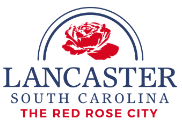WELCOME TO HISTORIC LANCASTER, SC
History is alive and well in Lancaster, South Carolina, the Red Rose City.
Established in the mid 1700’s by Scots-Irish and English settlers from the region of the famous House of Lancaster, this area was viewed as a “Garden of Eden.” Over the years, the area has hosted two wars on its soil and has nurtured several famous native sons, among them Andrew Jackson, seventh President of the United States; William R. Davie, founder of the University of North Carolina; Stephen D. Miller, South Carolina’s twenty-fifth governor; Dr. J. Marion Sims, the father of modern gynecology; Elliott White Springs, textile industrialist; Nina Mae McKinney, actress and Broadway star; Charles Duke, astronaut and moon-walker; and Jim Hodges, 114th governor of South Carolina. Both the City of Lancaster and Lancaster County are filled with many historical sites dating back to pre-Revolution times. Click on the links above to discover all the interesting and wonderful locations we have to offer.
The Lancaster area was, in its day, literally a Garden of Eden for the Native Americans, including the Cherokee, the Catawba, and the Waxhaw tribes. The arrival of Scots-Irish settlers, mostly from Lancaster, Pennsylvania, ushered in an era of drastic change. The newcomers named the area for their homelands in England, the region of the famous House of Lancaster that opposed the House of York in the legendary War of the Roses. Today, the citizens of the City of Lancaster proudly claim the red rose, the traditional coat of arms of the House of Lancaster, as their emblem.
In 1759, the Waxhaw Presbyterian Church was established as a center of faith and society. Its pastor, the Reverend William Richardson, organized the Waxhaw Academy were many South Carolina notables were educated. The short list includes Andrew Jackson, Lancaster native and seventh president of the United States; Stephen D. Miller, South Carolina’s twenty-fifth governor; and William R. Davie, founder of the University of North Carolina.
The independent spirit of Lancaster’s Scots-Irish settlers drew unwelcome attention from the British during the Revolutionary War, and several skirmishes were waged in the immediate area in 1780, including Buford’s Massacre and Hanging Rock.
Lancaster was originally known as Barnettsville when the first courthouse was erected in 1795. In 1802, an application was made for a charter for the village of Lancaster. A court dispute over the original plat was not resolved until 1824. By 1825, its jail and courthouse were erected. Both were designed by Robert Mills, the renowned American architect who studied under Thomas Jefferson and later designed the Washington Monument. In December 1830, by Act of the South Carolina State Legislature, the Town of Lancaster was incorporated and provision was made for the election of town officials. The first election was held on the first Monday in March 1831 and Andrew Mayer was elected as Mayor. The Town of Lancaster was re-chartered in 1898 and as the City of Lancaster in 1967.
During the Civil War, troops under General William Tecumseh Sherman occupied the town on their way to Virginia after the Southern campaign in 1865. Union soldiers attempted to burn both the Courthouse and the Jail. Damage was not severe to either building, but many wills and other important papers were destroyed. The soldiers looted the town and stabled their horses in the sanctuary of the Presbyterian Church, which had been built in 1862.
In the period of recovery following the war, Col. Leroy Springs founded Springs Cotton Mill in 1895, an industrial enterprise that grew to become the “largest textile plant in the world.” Global in scope, Springs Industries shaped the fortunes of Lancaster and its citizens for more than 100 years. The “Springs Block” along Main Street is evidence of Springs’ tremendous influence.
Today, Lancaster’s mills are silent, yet the town retains its character and vitality. Close to the Charlotte, North Carolina, metropolitan area, this quiet, quaint “garden spot” is attracting new visitors, businesses, and residents with its allure. Some things never change.
